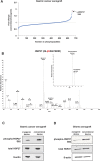Phosphoproteomic profiling of tumor tissues identifies HSP27 Ser82 phosphorylation as a robust marker of early ischemia
- PMID: 26329039
- PMCID: PMC4557083
- DOI: 10.1038/srep13660
Phosphoproteomic profiling of tumor tissues identifies HSP27 Ser82 phosphorylation as a robust marker of early ischemia
Abstract
Delays between tissue collection and tissue fixation result in ischemia and ischemia-associated changes in protein phosphorylation levels, which can misguide the examination of signaling pathway status. To identify a biomarker that serves as a reliable indicator of ischemic changes that tumor tissues undergo, we subjected harvested xenograft tumors to room temperature for 0, 2, 10 and 30 minutes before freezing in liquid nitrogen. Multiplex TMT-labeling was conducted to achieve precise quantitation, followed by TiO2 phosphopeptide enrichment and high resolution mass spectrometry profiling. LC-MS/MS analyses revealed phosphorylation level changes of a number of phosphosites in the ischemic samples. The phosphorylation of one of these sites, S82 of the heat shock protein 27 kDa (HSP27), was especially abundant and consistently upregulated in tissues with delays in freezing as short as 2 minutes. In order to eliminate effects of ischemia, we employed a novel cryogenic biopsy device which begins freezing tissues in situ before they are excised. Using this device, we showed that the upregulation of phosphorylation of S82 on HSP27 was abrogated. We thus demonstrate that our cryogenic biopsy device can eliminate ischemia-induced phosphoproteome alterations, and measurements of S82 on HSP27 can be used as a robust marker of ischemia in tissues.
Conflict of interest statement
EN holds shares in Robin Medical that may gain financially from the publication of this manuscript. Patents for the cryogenic biopsy device are also being applied.
Figures




Similar articles
-
Quantitative phosphoproteomic analysis of porcine muscle within 24 h postmortem.J Proteomics. 2014 Jun 25;106:125-39. doi: 10.1016/j.jprot.2014.04.020. Epub 2014 Apr 24. J Proteomics. 2014. PMID: 24769528
-
Delayed times to tissue fixation result in unpredictable global phosphoproteome changes.J Proteome Res. 2013 Oct 4;12(10):4424-34. doi: 10.1021/pr400451z. Epub 2013 Sep 17. J Proteome Res. 2013. PMID: 23984901
-
Phosphoproteome study reveals Hsp27 as a novel signaling molecule involved in GDNF-induced neurite outgrowth.J Proteome Res. 2009 Jun;8(6):2768-87. doi: 10.1021/pr801052v. J Proteome Res. 2009. PMID: 19290620
-
Simultaneous quantification of protein phosphorylation sites using liquid chromatography-tandem mass spectrometry-based targeted proteomics: a linear algebra approach for isobaric phosphopeptides.J Proteome Res. 2014 Dec 5;13(12):5452-60. doi: 10.1021/pr500339u. Epub 2014 Nov 17. J Proteome Res. 2014. PMID: 25403019
-
Phosphorylation of Ser78 of Hsp27 correlated with HER-2/neu status and lymph node positivity in breast cancer.Mol Cancer. 2007 Aug 14;6:52. doi: 10.1186/1476-4598-6-52. Mol Cancer. 2007. PMID: 17697330 Free PMC article.
Cited by
-
Phosphoproteomic analysis sheds light on intracellular signaling cascades triggered by Formyl-Peptide Receptor 2.Sci Rep. 2019 Nov 29;9(1):17894. doi: 10.1038/s41598-019-54502-6. Sci Rep. 2019. PMID: 31784636 Free PMC article.
-
Global profiling of O-GlcNAcylated and/or phosphorylated proteins in hepatoblastoma.Signal Transduct Target Ther. 2019 Oct 11;4:40. doi: 10.1038/s41392-019-0067-4. eCollection 2019. Signal Transduct Target Ther. 2019. PMID: 31637018 Free PMC article.
-
Tyrosine Phosphorylation as a Widespread Regulatory Mechanism in Prokaryotes.J Bacteriol. 2019 Sep 6;201(19):e00205-19. doi: 10.1128/JB.00205-19. Print 2019 Oct 1. J Bacteriol. 2019. PMID: 31262836 Free PMC article. Review.
-
Common errors in mass spectrometry-based analysis of post-translational modifications.Proteomics. 2016 Mar;16(5):700-14. doi: 10.1002/pmic.201500355. Proteomics. 2016. PMID: 26667783 Free PMC article. Review.
-
Glycolysis in hepatic stellate cells coordinates fibrogenic extracellular vesicle release spatially to amplify liver fibrosis.Sci Adv. 2024 Jun 28;10(26):eadn5228. doi: 10.1126/sciadv.adn5228. Epub 2024 Jun 28. Sci Adv. 2024. PMID: 38941469 Free PMC article.
References
-
- Graves J. D. & Krebs E. G. Protein Phosphorylation and Signal Transduction. Pharmacol. Ther. 82, 111–121 (1999). - PubMed
-
- Andersen J. N. et al. Pathway-Based Identification of Biomarkers for Targeted Therapeutics: Personalized Oncology with PI3K Pathway Inhibitors. Sci. Transl. Med. 2, 43ra55–43ra55 (2010). - PubMed
-
- Krause D. S. & Van Etten R. A. Tyrosine Kinases as Targets for Cancer Therapy. N. Engl. J. Med. 353, 172–187 (2005). - PubMed
-
- Petricoin E. F. et al. Mapping Molecular Networks Using Proteomics: A Vision for Patient-Tailored Combination Therapy. J. Clin. Oncol. 23, 3614–3621 (2005). - PubMed
-
- Rikova K. et al. Global Survey of Phosphotyrosine Signaling Identifies Oncogenic Kinases in Lung Cancer. Cell 131, 1190–1203 (2007). - PubMed
Publication types
MeSH terms
Substances
Grants and funding
LinkOut - more resources
Full Text Sources
Other Literature Sources
Molecular Biology Databases
Research Materials
Miscellaneous

